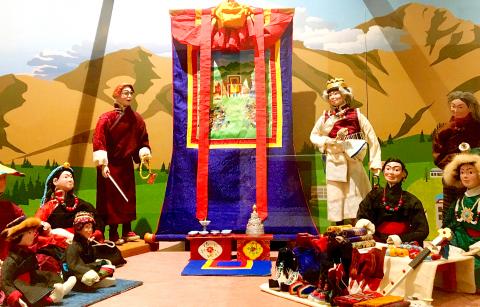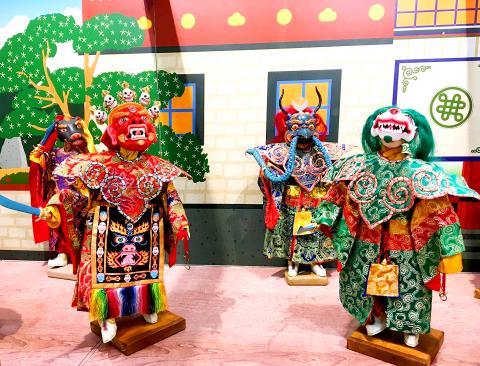Opening tomorrow, Tibet at a Glance: Special Exhibition of Tibetan Miniatures at the Mongolian and Tibetan Cultural Center showcases Tibetan figurines made by monks at the Drepung Loseling Monastery in India.
Decked out in traditional clothes, the figurines are an introduction to the profound and diverse culture of Tibet. The exhibition will cover seven themes: kings and ministers; Lhasa street scenery; Tibetan costume; vajra or tantric dance; prayer; Milarepa, a celebrated historical figure in Tibetan Buddhism; and Tibetan theater.
Drepung Loseling Monastery itself has a fascinating history. Established in 1416, the original Drepung Monastery was regarded as the most important monastery of the Gelug school of Tibetan Buddhism. Located at the foot of Mount Gephel on the outskirts of Lhasa, in its heyday, the monastery housed 7,700 monks and was thought to be the largest in the world.

Photo courtesy of Ministry of Culture
After the Tibetan uprising in 1959 and China’s ensuing crackdown on Tibetan governance, religious and social structures, about 250 monks from Drepung Monastery escaped to India, where they founded Drepung Loseling Monastery in the spirit of the original. This “monastery in exile” now houses more than 3,000 monks.
Tibet at a Glance is part of the ongoing Tibetan Culture and Art Festival, organized by the Ministry of Culture and now in its fifth year.
The festival program also includes four talks conducted in Mandarin on Tibetan life, death and wedding rites; Tibetan documentaries; spirituality; and Tibetan yoga. The talks will take place tomorrow and on Jan. 18, Feb. 22 and March 14 next year respectively. In addition, there will be interactive sessions to make hand-molded rice flour figurines and paper crafts on Dec. 28 this year and March 21 next year respectively.

Photo courtesy of Ministry of Culture
■ Tibet at a Glance: Special Exhibition of Tibetan Miniatures shows until March 31 next year and is open Mondays to Saturdays, 9am to 6pm at the Mongolian and Tibetan Cultural Gallery (蒙藏文化館), 3, Lane 8, Qingtian St, Taipei City (臺北市青田街八巷三號).
■ Online registration is required for the talks and hands-on activities at: event.culture.tw/MOC. Several events are already booked.

May 11 to May 18 The original Taichung Railway Station was long thought to have been completely razed. Opening on May 15, 1905, the one-story wooden structure soon outgrew its purpose and was replaced in 1917 by a grandiose, Western-style station. During construction on the third-generation station in 2017, workers discovered the service pit for the original station’s locomotive depot. A year later, a small wooden building on site was determined by historians to be the first stationmaster’s office, built around 1908. With these findings, the Taichung Railway Station Cultural Park now boasts that it has

Wooden houses wedged between concrete, crumbling brick facades with roofs gaping to the sky, and tiled art deco buildings down narrow alleyways: Taichung Central District’s (中區) aging architecture reveals both the allure and reality of the old downtown. From Indigenous settlement to capital under Qing Dynasty rule through to Japanese colonization, Taichung’s Central District holds a long and layered history. The bygone beauty of its streets once earned it the nickname “Little Kyoto.” Since the late eighties, however, the shifting of economic and government centers westward signaled a gradual decline in the area’s evolving fortunes. With the regeneration of the once

The latest Formosa poll released at the end of last month shows confidence in President William Lai (賴清德) plunged 8.1 percent, while satisfaction with the Lai administration fared worse with a drop of 8.5 percent. Those lacking confidence in Lai jumped by 6 percent and dissatisfaction in his administration spiked up 6.7 percent. Confidence in Lai is still strong at 48.6 percent, compared to 43 percent lacking confidence — but this is his worst result overall since he took office. For the first time, dissatisfaction with his administration surpassed satisfaction, 47.3 to 47.1 percent. Though statistically a tie, for most

In February of this year the Taipei Times reported on the visit of Lienchiang County Commissioner Wang Chung-ming (王忠銘) of the Chinese Nationalist Party (KMT) and a delegation to a lantern festival in Fuzhou’s Mawei District in Fujian Province. “Today, Mawei and Matsu jointly marked the lantern festival,” Wang was quoted as saying, adding that both sides “being of one people,” is a cause for joy. Wang was passing around a common claim of officials of the People’s Republic of China (PRC) and the PRC’s allies and supporters in Taiwan — KMT and the Taiwan People’s Party — and elsewhere: Taiwan and